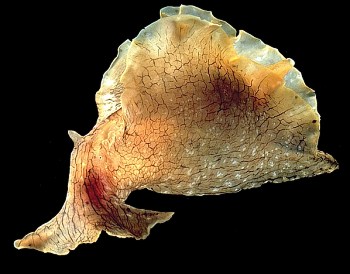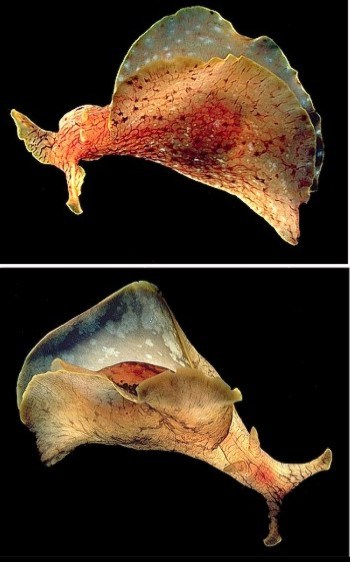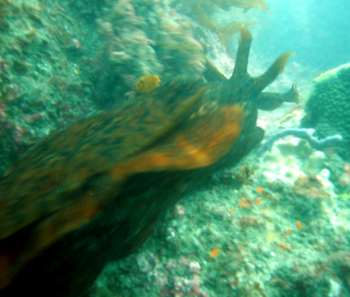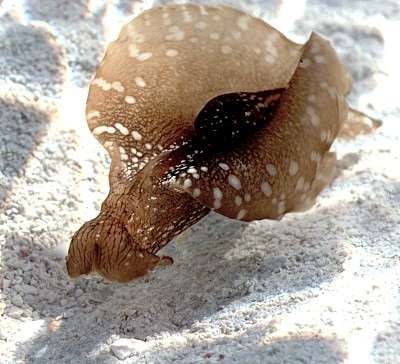

Aplysia extraordinaria
(Allan, 1932)
Order: ANASPIDEA
Superfamily: APLYSIOIDEA
Family: Aplysiidae
DISTRIBUTION
East coast of Australia. Recorded from northern New Zealand. Probably a much wider distribution under various names.
PHOTO
Port Stephens, New South Wales, October 1980. Many specimens, up to 120mm long. PHOTOS: Bill Rudman.
This spectacular Aplysia can grow to more than 400mm in length. It is quite common at times in some of the large bays and inlets along the New South Wales coast of eastern Australia, large numbers often washing up on the shore. It is an active swimmer, vigorously flapping its large parapodia and rhythmically flexing its body up and down. It produces clouds of reddish-purple ink when disturbed. It is possible that this species has a much wider distribution, as I remember finding an almost identical species in east Africa. The animal identified as Aplysia gigantea Sowerby, 1869 from Western Australia is almost certainly the same species. If the identification is correct then the name would have precedence over A. extraordinaria.
See the General Topics List for more information on Sea Hares.
Reference:
• Allan, J.K. (1932). A new genus and species of sea-slug, and two new species of sea-hares from Australia. Records of the Australian Museum 18(6): 314-320.
Rudman, W.B., 1999 (May 3) Aplysia extraordinaria (Allan, 1932). [In] Sea Slug Forum. Australian Museum, Sydney. Available from http://www.seaslugforum.net/find/aplyextr
Related messages
Large tubercled ?Aplysia at Little Bay, Sydney
March 18, 2010
From: Kirsten Crosby
I saw what I think was an Aplysia today (14 March 2010) on the southern side of Little Bay (Sydney) in the rock pools, about 5 cm under the water, flattened across a rock. It was about 15 cm long, pale grey/brown in colour with darker brown tubercles all over its dorsal surface. I have seen many A. gigantea around Maroubra, La Perouse etc, but this was quite different. I would love to know what species it was. Unfortunately did not have my camera with me.
Locality: Little Bay, Sydney, 5 cm, NSW, Australia, Pacific Ocean, 14/3/2010, Rock Pools. Length: 15cm
cheers
Kirsten Crosby,
Sydney
kirsten.crosby@gmail.com
Crosby, K., 2010 (Mar 18) Large tubercled ?Aplysia at Little Bay, Sydney. [Message in] Sea Slug Forum. Australian Museum, Sydney. Available from http://www.seaslugforum.net/find/23346Dear Kirsten,
I suspect from your description of a 'flattened' Aplysia that the animal you saw was Dolabrifera brazieri. Have a look at the Fact Sheet for that species, and the attached messages, for photos and information on the species.
We usually call the animal you identify as A. gigantea by the name A. extraordinaria. As I say on that Fact Sheet, it is almost certainly the same as the Western Australian A. gigantea.
Best wishes,
Bill Rudman
Aplysia extraordinaria from Nelson's Bay, New South Wales
June 18, 2007
From: Bruce Potter

Dear Bill,
When I was diving in Nelson Bay, I saw and photographed many sea hares. I identified some as Aplysia juliana and then I saw the message from David and Leanne Atkinson [#19204] I wondered if I had identified mine correctly.
These would have been around 300 mm long and were all found in sea grass at depths of 5 to 10 metres.
Locality: Fly Point, Nelson Bay, 5 to 10 mtr, NSW, Pacific, 2006, Sea Grass and sponges. Length: 300mm. Photographer: Bruce Potter.
Regards
Bruce Potter.
bandppotter@bigpond.com
Potter, B., 2007 (Jun 18) Aplysia extraordinaria from Nelson's Bay, New South Wales. [Message in] Sea Slug Forum. Australian Museum, Sydney. Available from http://www.seaslugforum.net/find/19407
Dear Bruce,
You are right to doubt that these are A. juliana. The upper photo is definitely Aplysia extraordinaria which, as I discussed in the Atkinson's message, has very large parapodia which it uses for swimming. I am not so sure about the animal in your lower photo, which looks more like a large Aplysia sydneyensis, but it may be A. extraordinaria as well - just stretched out as it crawls along.
As you may gather from my comments, identifying Aplysia from photos is sometimes more of an arcane art than a precise science.
Best wishes,
Bill Rudman
Aplysia extraordinaria from nthn New Zealand
March 12, 2007
From: Rendt Gorter


Is this a specimen of Aplysia extraordinaria?
I discovered this specimen in abundance (a short search in 50 sq metre area revealed dozens) here on Great Barrier Island, 80 n. miles NE of Auckland, New Zealand.
The sea slug, if indeed it is a Sea Hare, would swim by waving the mantle and releasing purple ink when disturbed
Locality: Kaitoke Stream, a shallow estuary, 50 m from shore, on shallow sand. Great Barrier Island, 0.5 m, New Zealand, Pacific Ocean, 9 March 2007, Estuary, sand bottom. Length: 10-15 cm. Photographer: Rendt Gorter.
Rendt Gorter
rendt@gorter.gen.nz
Gorter, R., 2007 (Mar 12) Aplysia extraordinaria from nthn New Zealand. [Message in] Sea Slug Forum. Australian Museum, Sydney. Available from http://www.seaslugforum.net/find/19642
Dear Rendt,
Yes this is A. extraordinaria. It is considered to be quite a rare visitor to nthn New Zealand, but we really don't have enough information. Another very large swimming species, which I have tentatively identified as Aplysia sagamiana [see message #14048], may be a colour form of A. extraordinaria but the brown rings on the parapodia seem quite distinctive.
Best wishes,
Bill Rudman
Giant Sea Hare from Sydney Harbour
March 1, 2007
From: Amy Shek


Hi Bill,
I met a Giant MONSTER SEA HARE at Camp Cove, Sydney Harbour (5m depth)last Sunday(18/2/07)while diving.
I mean REALLY REALLY BIG ONE, when I saw it, I took off my fin and put it next to it and it was just about the same size as my fin (fin length: 25inches) photos attached.
Locality: Camp Cove - Sydney Harbour, 5 metres, NSW, Australia, 18 February 2007, sandy bottom. Length: 25 inches. Photographer: Amy Shek.
Could you please identify this sea hare for me?
Wonder what is the biggest size of sea hare that can grown to?
Thanks.
Amy Shek
ashek@tpg.com.au
Shek, A., 2007 (Mar 1) Giant Sea Hare from Sydney Harbour. [Message in] Sea Slug Forum. Australian Museum, Sydney. Available from http://www.seaslugforum.net/find/19519
Dear Amy,
Somewhere in the Forum I ask participants not to use CAPITALS as it is a form of internet shouting - but I guess in this case you are allowed to be a bit excited. 25 inches [= 65 cm] is definitely a large slug. Your animal is Aplysia extraordinaria which is found down the east coast of Australia, and is possibly the same as another large sea hare in Western Australia called Aplysia gigantea, which apparently grows a bit bigger. I haven't kept a record of the largest A. extraordinaria reported, but yours must be up near the biggest.
However I am afraid it has a way to go compared with Aplysia vaccaria from the west coast of North America which has been reported to grow to 99 cm [= 39 inches] in length.
Have a look at the Fact Sheets and accompnying messages for more information.
Best wishes,
Bill Rudman
Our first meeting with a sea slug
August 29, 2006
From: James Salama
Hi I'm 10years old and have a question about sea slugs.
Yesterday while we were walking along Corlette Beach we saw what we now know is a sea slug. It appeared to have washed in with the tide. We pushed him further out to sea he seemed to swim away. Today we have been looking on the internet to find out what it was we saw.
Thank you for having this site now we know what it was. We didn't have camera with us so no photos. It was brown coloured with black spots.
Locality: Corlette Beach, Corlette. Poert Stephens NSW, shoreline Low tide., NSW Australia, 25th August 2006, at the edge of the water. Length: approx 8 cm.
Could you tell me if sea slugs are usually seen close to the shore. My mum and dad had never seen one. We are wondering if we were just very lucky to have seen the sea slug.
Thanks
James Salama
rmsalama@optusnet.com.au
Salama, J., 2006 (Aug 29) Our first meeting with a sea slug. [Message in] Sea Slug Forum. Australian Museum, Sydney. Available from http://www.seaslugforum.net/find/17639Dear James,
Since your sea slug was washed up, and swam when you put it back in the water, I guess you probably saw a Sea Hare, and one likely species in Port Stephens is Aplysia extraordinaria. In fact if you look on the Fact Sheet for that species, the photos are of animals from Port Stephens. If you go to the General Topics Index [in Menu at top left of page] you will find a list of Fact Sheets on Sea Hares. Sometimes they are very common in rock pools and sometimes they wash up in large numbers on sandy beaches.
Since sea slugs live in water you don't usually find them washed up on beaches, but if you look in rock pools and under rocks you may be lucky to find some of the more brilliantly coloured nudibranch sea slugs. Be careful if you turn over rocks to put them back they way you found them so that all the plants and animals living on the underside of the rocks don't dry out. Port Stephens is a very interesting place for sea slugs and scuba divers have found a great variety of species living there, some of which are more common in tropical waters. If you type port stephens in the SEARCH box you will get a long list of messages about different kinds of sea slugs found in Port Stephens.
Best wishes,
Bill Rudman
Juvenile Aplysia extraordinaria from Sydney
August 16, 2006
From: Donald Miles

Hi,
Just wondering if someone could identify this sea slug for us. It was found at Long Reef Marine Reserve in a large tidal rock pool.
Locality: Long Reef Rock Platform, Collaroy, 0 - 1 metre, NSW, Australia, Pacific Ocean, 8 August 2006, Tidal rock pool. Length: 50mm. Photographer: Don Miles.
I have included some photos taken through a plastic specimen container showing the top and underside of the slug.
Thanks,
Don Miles
AUSECO
auseco@optusnet.com.au
Miles. D.W., 2006 (Aug 16) Juvenile Aplysia extraordinaria from Sydney. [Message in] Sea Slug Forum. Australian Museum, Sydney. Available from http://www.seaslugforum.net/find/17435
Dear Don,
From the general shape I would suspect that this is a juvenile of the large sea hare, Aplysia extraordinaria. They are normally more brown in colour, but it is possible that juveniles, if feeding on red algae, would have a pinkish tinge. Unfortunately we know very little about the life history of this species.
Best wishes,
Bill Rudman
Aplysia gigantea / A. extraordinaria
October 27, 2005
From: Stephen Davison

On Saturday I was diving off Kurnell National Park, Sydney, and saw my first Sea hare! I was flabbagasted at the size of it ( I didn't even know they existed, this my 305th dive!) as i read on your site, trying to id it I noticed the discrepancy with id on Aplysia gigantea / Aplysia extraordinaria. The A. gigantea from Western Australia is EXACTLY like the one I saw off Sydney...
Locality: "Monument park" Kurnell National park, Sydney, NSW, Australia. Depth: approx 10 m. Length: Approx 500-600 mm. 22 October 2005. Rock reef, within 30 m of shore, some kelp. Photographer: Stephen Davison
The colouring was dark reddish brown ( like picture) and the size was more like 600 mm rather than the 400 mm described for the A. extraordinaria. I have some very bad pics wich I may attach but the they are the worst pics I've taken in about 100 dives, I was so amazed at this "over grown snail" I sort of forgot to do much then my buddy was bored and gone! I have better( not much better) MPG video that I might get a decent still off later...
I don't know how heated the debate is about the similarity of the two species but I hope this might help towards some understanding!
In one photo I lamely put my hand in to get scale... doesn't work very well. If I'd realised how significant it might be...!
Stephen Davison
stephen_davison@hotmail.com
Davison, S., 2005 (Oct 27) Aplysia gigantea / A. extraordinaria. [Message in] Sea Slug Forum. Australian Museum, Sydney. Available from http://www.seaslugforum.net/find/15107
Dear Stephen,
Congratulations on your first Aplysia sighting! Fortunately, we are not planning to go to war over the Aplysia gigantea - Aplysia extraordinaria debate, so don't feel guilty about your photos or lack of precise measurement. In fact I don't even know if you could call it a debate. Apart from Fred Wells' paper on A. extraordinaria, in 1986, and my comments on the Forum, I don't think anyone else has joined in.
I am pretty sure they are the same species, and it is possible a large species on the east coast of Africa is the same. There are similar species' doubts which need to be resolved in other parts of the world, such as is the common west Atlantic species Aplysia brasiliana the same as the east Atlantic species A. fasciata?[see #12545]
Unfortunately there are too few marine biologists being supported worldwide for such questions to be high on anyone's priority list. Thanks for letting us know of your sighting. We are building up a lot of valuable information from contributions such as yours.
Best wishes,
Bill Rudman
Re: Aplysia extraordinaria from New Zealand
June 15, 2005
From: Julie Marshall
Dear Bill,
In response to your query [message #14048] whether anyone had seen Aplysia extraordinaria swimming, I sent you a photo of one swimming which appeared on the forum on 14 September 1999 [#1329]. However, it was a much smaller animal - only 120 mm in size.
Best wishes,
Julie Marshall
juliemarshall@netspace.net.au
Marshall, J.G., 2005 (Jun 15) Re: Aplysia extraordinaria from New Zealand. [Message in] Sea Slug Forum. Australian Museum, Sydney. Available from http://www.seaslugforum.net/find/14061Dear Julie,
Sorry I should have made myself clearer. A. extraordinaria is definitely a swimmer. I was just wondering whether I had correctly identified this large New Zealand animals correctly. If it has never been seen swimming, perhaps it is not A. extraordinaria.
Best wishes,
Bill Rudman
Aplysia extraordinaria? from Townsville
August 7, 2003
From: Adam Coxhead
Hello,
My friend and I found a group of sea hares (about 10 or so) which I think are Aplysia extraordinaria in Ross River, Townsville, Queensland. The site was about 8 kms away from the river's mouth. Is it unusual to find these animals so far away from the ocean? They were all about 15-30cm long.
Thanks for any information,
Adam
rich@beyond.net.au
Coxhead, A., 2003 (Aug 7) Aplysia extraordinaria? from Townsville. [Message in] Sea Slug Forum. Australian Museum, Sydney. Available from http://www.seaslugforum.net/find/10671Dear Adam,
Where Sea Hares live is more dependent on the salinity of the water rather than the distance from the open sea. Many Sea Hares live in coastal lagoons, mangroves, aquaculture ponds etc, so I guess that where you found these animals is a tidal part of the Ross River with little, if any, dilution from freshwater.
Concerning your identification. It would be interesting to see photos of your animals, and any information on whether it swims or not. Most records of this species suggest it has a southeastern Australian - nthn New Zealand distribution, although we do have a record of Julie Marshall's of one from Heron Island at the southern end of the Great Barrier Reef. It is also probable that Aplysia gigantea from Western Australia, is the same species, and that records from other parts of the Indian Ocean and the Pacific are of the same species. So any further information on its possible distribution would be of interest.
Best wishes,
Bill Rudman
Re: Sea Hare? from Stockton, NSW
November 29, 2002
From: Peter Ruxton
Dear Bill,
Thanks for your reply. When I rolled one over in the sand at the waters edge a dark purple coloured liquid was ejected. The creature I saw does look like a Sea Hare but not hairy like Bursatella leachii. They were similar in form, but not color, to the photographs at your web site of Aplysia parvula.
Thankyou
Peter Ruxton
rucko@bigpond.com
Ruxton, P., 2002 (Nov 29) Re: Sea Hare? from Stockton, NSW . [Message in] Sea Slug Forum. Australian Museum, Sydney. Available from http://www.seaslugforum.net/find/8542Dear Peter,
The purple ink pretty much confirms they are a Sea Hare of some sort, as most species produce a red or purple coloured ink. If they were not hairy, and sometimes swam, they are most likely to be a species we call Aplysia extraordinaria in eastern Australia. It is probably the same as a species from Western Australia we call Aplysia gigantea.
Why were they washed up in large numbers? Have a look at the page on Mass mortality for some background information on this. Dead and dying Sea Hares often cause alarm or interest in many parts of the world. Recently we have had messages from the Mediterranean about this topic, and last year a large washup of the huge A. gigantea in Western Australia resulted in the death of some pet dogs.
Best wishes,
Bill Rudman
Sea Hare? from Stockton, New South Wales
November 28, 2002
From: Peter Ruxton
About a week ago at a period of very low tides it was noticed that a small black, grey, purple, brown, blue coloured creature as big as say a mans fist was noticed in large numbers in the Hunter River at Stockton [near Newcastle, New South Wales, Australia]. Some had washed up and were lying on the sand, or swimming free in the water just like a Spanish Dancer and others just lying on the bottom. They all had protusions just like nudibranchs. On looking at these creatures I got the definate impression they were not jelly fish but nudibranchs and they had a slug like body.
What are they?
Peter Ruxton
rucko@bigpond.com
Dear Peter,
It's a bit hard to be sure what you have seen without a photo or drawing or some idea of the shape of these animals. One possibility is a Sea Hare of some sort. Did any of them produce a red or purple ink? Have a look at the page on the Forum for Bursatella leachii. If you scroll down the page you'll find a message and photos from Coffs Harbour which show this animal quite well. Let me know if my guess is anywhere near the mark. Otherwise a photo or
drawing might give me a few more clues
Cheers,
Bill Rudman
Aplysia extraordinaria? from New Zealand
August 18, 2001
From: Wade Doak


Dear Bill
Has Aplysia extraordinaria been recorded from New Zealand?
By the process of elimination [its huge size] I think this must be the one turning up at the Poor Knights sporadically over the years. I attach some old shots. The second one shows it is quite a handful. I am sure kiwi viewers would have more recent shots.
Wade Doak
wade@aotea.co.nz
Doak, W., 2001 (Aug 18) Aplysia extraordinaria? from New Zealand. [Message in] Sea Slug Forum. Australian Museum, Sydney. Available from http://www.seaslugforum.net/find/5102Thanks Wade,
Yes A. extraordinaria is recorded in Spencer & Willan (1996) from northern New Zealand, and your photos certainly confirm the record. I presume you have seen it swimming? If someone has some photos of this animal from New Zealand, preferably with some locality data, it would be an interesting record to include on the Forum.
Reference:
• Spence, H.G. & Willan, R.C. (1996) The Marine Fauna of New Zealand: Index to the Fauna 3. Mollusca. New Zealand Oceanographic Institute Memoir, 105 (for 1995): [Opisthobranchs on pp 32-37]
Best wishes,
Bill Rudman
Aplysia extraordinaria from Sydney Harbour
January 3, 2000
From: Stephanie Clark

Dear Bill
Well here is one of the photos I promised to send. It is probably Aplysia extraordinaria - since it did swim.
The specimen was about 18cm and was found stranded on the mud on the out going tide, on Rodd Island, Iron Cove, Sydney Harbour, on the 22 Nov 1999. Once the specimen was placed back in the water it started to swim. It was the only sea hare seen on the day. Have a look at my message about Dendrodoris denisoni
Regards,
Stephanie.
inverte@internet-australia.com
Clark, S., 2000 (Jan 3) Aplysia extraordinaria from Sydney Harbour. [Message in] Sea Slug Forum. Australian Museum, Sydney. Available from http://www.seaslugforum.net/find/1623Thanks Steph,
It's definitely Aplysia extraordinaria. To those not familiar with Sydney, Iron Cove is one of the bays and inlets around which the centre of the city is built, and until recently was part of a seriously polluted busy industrial port. In recent years containerisation and the shift of heavy industry to outlying areas has reduced the degree of pollution in the area, but it is still amazing that this area, just a few 100 metres from a still active and major port can still support a very healthy population of sea slugs and other marine life.
Bill Rudman.
Rudman, W.B., 2000 (Jan 3). Comment on Aplysia extraordinaria from Sydney Harbour by Stephanie Clark. [Message in] Sea Slug Forum. Australian Museum, Sydney. Available from http://www.seaslugforum.net/find/1623Aplysia extraordinaria - another swimmer
September 14, 1999
From: Julie Marshall

Dear Bill,
In the last few months there have been some messages about swimming sea hares from North America. Illustrated here is Aplysia extraordinaria swimming over the reef flat at Heron Island in July 1999. The animal was 120 mm in size.
Best wishes,
Julie Marshall
j.marshall@latrobe.edu.au
Marshall, J., 1999 (Sep 14) Aplysia extraordinaria - another swimmer. [Message in] Sea Slug Forum. Australian Museum, Sydney. Available from http://www.seaslugforum.net/find/1329Dear Julie,
At last the Forum has a swimming Sea Hare photo!
Thanks very much,
Bill Rudman.
